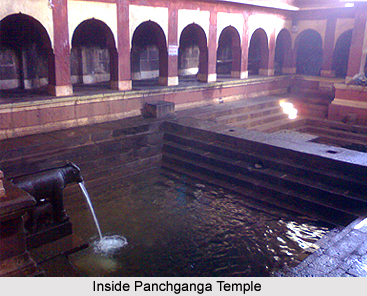 Panchganga Temple in Mahabaleshwar is one of the most prominent tourist attraction sites in Maharashtra. The word "Panch" means five and "Ganga" means river. It is believed that water from five different rivers like the Koyna River, Krishna River, Venna River, Savitri River and Gayatri River join near the Panchganga Temple.
Panchganga Temple in Mahabaleshwar is one of the most prominent tourist attraction sites in Maharashtra. The word "Panch" means five and "Ganga" means river. It is believed that water from five different rivers like the Koyna River, Krishna River, Venna River, Savitri River and Gayatri River join near the Panchganga Temple.
The water from all the five rivers comes out of a stone carved cow`s mouth. The temple is very beautiful and there is a statue of a bull, known as Nandi and there is a Lord Shiva lingam inside the Panchganga Temple which is very old.
The Panchganga Temple was built in the 13th century by Raja Singhandeo, the king of the Yadavas of Devgiri. In the 16th century the temple was improved by the Maratha Emperor Shivaji.
The people from all the parts of India come and visit this place. There are also many shops outside the temple from where the tourists can get strawberries and jellies. The strawberries and the jellies are famous in Mahabaleshwar.
This article is a stub. You can enrich by adding more information to it. Send your Write Up to content@indianetzone.com





















